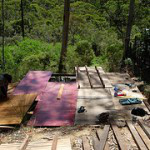2. Embedding rights as safeguards to our happiness
Arendt saw the rights to assembly, association, and speech as the most important truly political freedoms. Rights are legal, social, or ethical principles of freedom or entitlement, and incorporate values of fairness, equality, and justice. Within their scope, rights accommodate intergenerational equity, which by necessity involves social, economic, cultural, and environmental sustainability.
Arendt saw the economy as not just about production and consumption, but as a structure of power organising vital political issues, and as a system of ongoing relationships reinforcing patterns of distribution that reproduce inequalities and exploitation. From this, she identified a ‘right to have rights’; in times of economic hardship, she goes on to note, this recognition is withdrawn, leaving humans stateless and thus rightless. Arendt unfolded this theory by documenting the treatment of Jewish people throughout history.
Rights provide points of agreement when truth-telling is shared, and guide and make accessible to others the aims of allodoxic interventions. Rights can also provide support for ongoing activism working for the institutional, social, and personal aspects of freedoms, to the extent that, as law, they sustainably ground these themes within a community. However, Arendt warns that civil rights should not be mistaken for political freedoms; nor do they mean that the preliminaries of civilised government can be equated with the very substance of a free republic.[i] As is indicated by the loss of the legislation enacted by Emperor Justinian (527–565) in relation to the commons, and by the many examples of corporate intrusions into what were accepted rights of recent times, there is a need to continue to exercise, re-examine and improve rights. This includes developing new ones, as part of the protection and stabilisation of the private sphere and commons against the encroachments of the market. Allodoxic interventions can assist with the processes of politicisation that have an impact on both catastrophist and reform discourses, revealing their lies while simultaneously working towards making changes.
Pre-allodoxic interventions can incorporate the global approach of Italian law academic Stefano Rodotà, who outlines judicial interventions that allow commons goods to penetrate. He provides the example of the ruling by India’s Supreme Court allowing generic drugmakers to continue making generic versions of patented drugs. Rodotà believes this idea can be generalised, in the sense that:
A comprehensive definition of commons could refer to the goods functionally necessary for making effective a person’s fundamental rights and the fulfillment of his or her personality where the goods produced by commons reflect collective interests; are finalised by the fulfillment of collective needs; and make possible the effectiveness of fundamental rights.[ii]
Baroness Elsa refused to accept the governance, policy, and social norms and mores that supported wrongdoings, and she engaged in dissident confrontation with bureaucracies and their processes. In support of emancipation for women, she was regularly arrested and incarcerated for offences such as petty theft or public nudity during these actions, at a time when societal restrictions on female appearance were only just starting to soften.[iii]
Drawing from an article entitled ‘Performative Arts and Gender Constitution’ by American philosopher and gender theorist Judith Butler (b. 1956), Irene Gammel argues that Baroness Elsa’s radical activity is inextricably entwined with the risk that is central to allodoxic interventions. It is for this reason that Baroness Elsa’s practice fits into this category. She took a risk, performing in New York streets when there was no concept of social protest being conducted in this way. Similarly, artists in countries around the world today, including Western liberal democratic countries, are subject to bans on street protest and increased government militarism and surveillance. Under these circumstances, the exercise of democratic rights increasingly entails risk.[iv] My claim is that a theorisation of allodoxic art may provide protective measures for artists, even if it is transitory or delayed, and vulnerable to legal or political attack.[v]
In her article, Butler writes: ‘Gender is what is put on, invariably, under constraint, daily and incessantly, with anxiety and pleasure’. As Gammel points out, ‘Baroness Elsa’s public transgressions constitute a systemic assault against the traditional gender grammar’.[vi] Butler writes that, in contrast to theatrical performances, gender performances in non-theatrical contexts are governed by what are clearly punitive and regulatory social conventions. ‘On the street or in the bus, the act becomes dangerous because there are no theatrical conventions to delimit the purely imaginary character of the act’.[vii]
Baroness Elsa used a fake penis as a theatrical prop. This ‘was an act designed to dismantle the supreme signifier of patriarchal power’ and to highlight the new woman’s claim to sexual power. This is particularly important given that the suffragists were subject to aggressive media denigration as de-sexed men-women. Gammel suggests that Baroness Elsa was impersonating the position of all the militant women in New York: ‘the suffragists and birth-control activists who were frequently protesting on the public streets, most of them middle-aged women, parading non-feminine militance, refusing conventional feminine beauty and docility’.[viii]
In 2008, after a one-year delay, the Blue Mountains City Council approved my development application for a house design incorporating a railway carriage, a first for the Blue Mountains. The delay was caused by a decision by council staff that incorporating a steel train carriage into a house design did not meet ‘streetscape requirements’, even though no information could be provided on what these requirements were, apart from what can only be considered as their concept of good taste. Support letters for the proposal from neighbours, and the involvement of the city’s mayor, got the project approved and allowed it to proceed. The project aimed to explore issues relating to affordable housing, alongside environmental objectives of small scale and material re-use, potential fireproofing through the use of a solid steel structure, and my interest in building from a gleaner sculptural approach to contribute to the fact that women have traditionally built the majority of houses in the world. The Women’s Study Encyclopedia, Volume 2 uses the extended meaning of the term ‘Neolithic’ that was coined by archaeologists, applying it to ethnographic groups that do not produce metal tools but do produce horticulture. In this sense, the Neolithic began independently in many places when the glaciers of the Ice Age melted, and it continues in a few places into the present or recent past.
All Neolithic accomplishments, with the exception of polished stone tools, are designated more often as women’s work in cultures around the world. Women are more frequently potters, weavers, gardeners, and even house builders.[ix]
This intervention aims to provide people with the knowledge and the confidence to investigate the possibilities for cheaper and more environmentally sensitive designs for their houses, which require less maintenance and are matched to their living needs. Wider government acceptance of this approach could lead to developers genuinely exploring market preferences, rather than offering only the limited standard types of oversized houses. Offering a wide range of dwelling designs at affordable prices could alleviate crippling mortgage traps. This, in turn, could shift significant numbers of citizens to vote for social responsibility rather than financial security. The relentless exploitation that continues from uncontrolled speculative capital in the housing market has made property values since the mid-1950s soar by 8,000%.[x]
I held a solo exhibition about alternative housing and the commons as preliminary research for my Katoomba dwelling project in 2006 at Loose Projects. In my exploration of counter-culture models of designing and building I was drawn to the collective and environmental practices of the 1970s. One installation incorporated some of the achievements of John Archer, who was an early advisor for my house project in the Blue Mountains. This included three wall works by Archer, some of the magazines he co-founded, such as the Owner-Builder, and a 1980s video documentary in which he builds a mud-brick structure in remote Australia for and with Indigenous people recovering from petrol sniffing. The exhibition also included over ten of his books predicting and discussing Australia’s now widely known water crisis.
Between 2006 and 2011, my work was inspired by an interest in affordable eco-housing. It began with this exhibition and concluded with a report I wrote for Bankstown Creating Links Cooperative on the high levels of homelessness in Bankstown, an area where people are most in need. This report was a tool to assist the organisation with their lobbying efforts against the NSW government’s Metropolitan Strategy and the types and levels of housing being proposed. The organisation’s main argument against the proposal was that, evidenced in the research they had commissioned, this new housing would not alleviate the problem of homelessness in Bankstown.
[i] Hannah Arendt. Eichmann in Jerusalem: A Report on the Banality of Evil, (New York: Viking Press, 1963), p. 220.
[ii] Stefan Rodotà “Constituting the Commons in the Context of State, Law and Politics,” An international conference on the future of the commons: Economics and the Common(s) -From Seed Form to Core Paradigm, p. 8.
[iv] Michael Slezak, ‘NSW anti-protest laws an attack on democracy, say legal experts’, The Guardian Australia (15 March 2016 <https://www.theguardian.com/australia-news/2016/mar/15/nsw-anti-protest-laws-attack-democracy-law-groups>
[v] Even if there are few or no enabling or protective measures during the execution of interventions, the fact that this activity is framed as part of the art field means that the art field’s ‘machinery’, including the human rights movement as part of socio-politically engaged practice, can be mobilised to assist in the longer term when artists are imprisoned or face other legal penalties. Examples include the recent experiences of Chinese artist Ai Weiwei, American artist Steve Kurtz from Critical Art Ensemble and Cuban artist Tanya Bruguera.
Jenny Brown, Temporary Refuge 1. Mixed media installation
with re-used floors from Californian bungalows to be demolished
and corrugated iron, 5m x 5m x 4m. Katoomba, 2007.
Jenny Brown, Temporary Refuge 2. Plans of mixed media installation with train
carriage and wood, 17m x 10m x 12m. Katoomba, 2008.
[vi] Gammel, Baroness Elsa: Gender, Dada and Everyday Modernity, p. 196.
[vii] Judith Butler, ‘Performative Acts and Gender Constitution: An Essay in Phenomenology and Feminist Theory,’ in Performing Feminisms: Feminist Critical Theory and Theatre, ed. by Sue-Ellen Case (Baltimore: John Hopkins UP, 1990), pp. 272–282.
[viii] Gammel, Baroness Elsa: Gender, Dada and Everyday Modernity, pp. 193–194.
[ix] Helen Tierney (ed.), Women’s Studies Encyclopedia: Volume 2 (Connecticut: Greenwood Press, 1999), p. 981.
[x] Ben Dyson, ‘How Money Works’, Positive Money (14 September, 2014) <http://positivemoney.org/videos/presentations-by-positive-money/money-works-people-planet-ben-dyson-video/> [video accessed 20 October, 2014]


